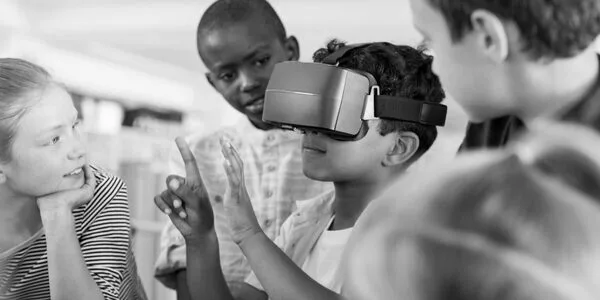Immersive virtual reality disrupts the child’s default coordination strategy, according to scientists, which should be considered when developing virtual reality rehabilitation protocols for children. While little is known about the effects of immersive VR on adults, little is known about the impact of such systems on the sensorimotor abilities of young children.
Jenifer Miehlbradt, an EPFL graduate, demonstrated her virtual reality setup that allows users to pilot drones using their torso at EPFL’s Open House in 2016. The general public was invited to wear a VR headset and navigate through a series of obstacles in a virtual landscape by moving their torso.
“Adults had no problem flying through the virtual obstacles using simple torso movements, but I noticed that children just couldn’t do it,” Miehlbradt recalls. “That’s when Silvestro invited me to his office.”
Miehlbradt’s supervisor at the time was Silvestro Micera, the Bertarelli Foundation Chair in Translational Neuroengineering. They realized that their virtual reality torso experiment might be revealing something about how a child’s nervous system develops, and that no study had assessed the effect of virtual reality headsets on children in the literature. In collaboration with the Italian Institute of Technology, they began a multi-year study involving 80 children aged 6 to 10. The findings were published today in the journal Scientific Reports.
“This study confirms the potential of technology to understand motor control,” says Micera.
The model states that from the acquisition of walking around 1 year until 6-7 years, children will control their upper body as a whole with rigid links between the trunk, head and arms. After this age, the children gradually learn to control all their joints independently, but resort to the rigid strategy in challenging conditions.
Jenifer Miehlbradt
The development of upper body coordination
Healthy adults have no trouble disconnecting their head movements from their torso for piloting, such as looking elsewhere while riding a bike. This necessitates the complex integration of multiple sensory inputs, including vision from the inner ear for balance and proprioception, the body’s ability to sense movement, action, and location.
Children’s coordination of torso and head movement is still developing, so differences with adults are to be expected. However, the EPFL study contradicts the dominant ontogenetic model of upper body coordination development over the last 25 years, which predicts a one-directional transition from rigid control to decoupling of the head-torso system and that postural control is essentially mature at 8 years.
“The model states that from the acquisition of walking around 1 year until 6-7 years, children will control their upper body as a whole with rigid links between the trunk, head, and arms. After this age, the children gradually learn to control all their joints independently, but resort to the rigid strategy in challenging conditions,” continues Miehlbradt, who is currently finishing a postdoc at the University of Lausanne (UNIL). “Instead, we found that when using a virtual system controlled by body movements, the younger children try to move their head and body separately, while the adults use the rigid strategy.”

The experiment: collecting coins on the back of an eagle
Children are asked to play two games while wearing a virtual reality headset and a movement sensor on their back. In both experiments, children demonstrate control abilities similar to adults when using their heads, but struggle to control the games when using their torsos, unlike adults.
In the first game, the child is asked to align their head or torso with a line displayed at different orientations within a virtual landscape, while the alignment error and head-torso coordination are measured. The experiment demonstrates that children can learn to control their heads fairly easily. When asked to align their torso with the virtual line, the youngest children consistently overestimate their movements and attempt to compensate by moving their head.
The second game consists of a flight scenario. In the virtual world, the child appears to be seated on the back of a flying eagle. The goal of the game is to catch golden coins placed along a path. Like the first game, control of the eagle’s trajectory is either with the head or with the torso. Again, using their head to steer the bird’s flight is significantly easier for children, who are 80% closer to the target coins compared to the torso-control condition.
Because the desired orientation is aligned with the visual input, the scientists believe that head control is easier in VR environments. Torso control, on the other hand, necessitates the user separating vision from actual control, which necessitates complex head-torso coordination. Young children rely more on visual input than internal sensations of body posture. The novelty of the virtual reality environment appears to overwhelm the child’s brain, causing it to pay less attention to internal signals.
“The results show that immersive VR can disrupt the children’s default coordination strategy, reweighting the various sensory inputs — vision, proprioception and vestibular inputs — in favor of vision,” explains Miehlbradt. The scientists also found that head-trunk coordination is not fully mature yet at 10 years, instead of the previously assumed maturity at the age of 8.
Leisure and Rehabilitation using VR
“VR is becoming increasingly popular for therapeutic applications such as rehabilitation and neurorehabilitation, as well as the treatment of phobias or fearful situations. The variety of scenarios that can be created, as well as the playful aspect that can be introduced into otherwise tedious activities, make this technology especially appealing for children. However, we should be aware that immersive VR can disrupt the child’s default coordination strategy” Miehlbradt is cautious.
















